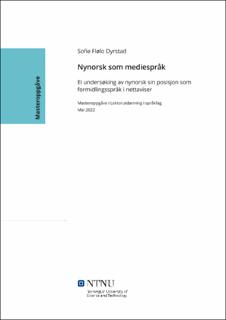| dc.description.abstract | Nynorsk og bokmål har alltid hatt eit asymmetrisk forhold. To plassar dette kjem tydeleg fram, er i aviser og gjennom språkhaldningane blant folk. Det er eit stort overtal av bokmål i dei norske avisene, og fram til 2017 godtok ikkje dei store riksavisene at nokre journalistar ville skrive på nynorsk. I avisene kan ein lese fleire lesarinnlegg der lesarar uttrykkjer at nynorsk er bortkasta og stiller spørsmål om kvifor ein i det heile tatt bør ha eit anna norsk skriftspråk enn bokmål. Denne masteroppgåva har som hensikt å undersøke posisjonen nynorsk har som formidlingsspråk i nettaviser, gjennom ei klikkmåling og kvalitative intervju med redaktørar i fem ulike aviser.
Tala frå klikkmålinga viser at bokmålssaker får fleire sidevisningar enn nynorsksaker, og fleire lesarar går ut av nynorsksakene før det har gått fem sekund, enn dei gjer i bokmålssakene. I klikkmålinga kjem det også fram at nynorsksakene blir lesen lengre, både i sekund og i lengde lesarane skrollar i saka. Vidare kan ein også sjå i undersøkinga at fleire lesarar les heile saka på nynorsk enn på bokmål. Gjennom å intervjue redaktørane kjem det fram fleire interessante funn, blant anna at det er større opning for nynorsk i media i dag. Fleire av redaktørane har inntrykk av at dei som er glade i nynorsk set pris på å lese det i media, medan dei som er bokmålsbrukarar ikkje bryr seg så mykje. | |
| dc.description.abstract | Nynorsk and bokmål has always had an asymmetrical relationship. This can be seen in several areas, whereas two of them are in newspapers and among the attitudes of general people. There is a large majority of bokmål in the Norwegian newspapers, and until 2017, the major national newspapers didn´t accept that some journalists wanted to write in nynorsk. In newspapers, one can read several comments in which readers express that nynorsk is wasted and question why we need another Norwegian written language, other than bokmål. The purpose of this master thesis is to uncover nynorsk’s position as a language of communication in online newspapers, through a click survey and qualitative interviews with editors in five different newspapers.
The click survey shows that articles in bokmål gets more page views than articles in nynorsk, and compared to bokmål articles, more readers goes out from the nynorsk articles before five seconds have passed. The click survey also shows that the nynorsk articles are read longer, both in seconds and in length of the article. Based on the survey, it also appears that more readers read the whole article in nynorsk than in bokmål. Through interviewing the editors, several interesting points emerged. Many of them agreed that nynorsk can be seen more in media today, and that the readers aren´t so negative to that. Some of them said that the people who like nynorsk appreciate it when an article is written in nynorsk, and that the users of bokmål don’t really care that much. | |
